How to Upload Excel File to Tableau
Our customers used to use Excel or other tools that aren't adapted to data discovery like Tableau is. Now nosotros can elevate dimensions and measures, meet if this or that visualization works, and optimize to get the insights we need. We easily iterate and don't have to rely on a long evolution process. We can share with other employees, and this gives our customers a 'wow' feel because they're used to having reports congenital by an IT department—and at present they tin exercise information technology all themselves.
PHILIP HOYOS, CONSULTANT & TABLEAU PRODUCT Director
Tableau is used past tens of thousands of businesses to clarify and generate insights from their data. Most businesses also use Excel, which has been the nigh popular spreadsheet application. While Excel allows users to evaluate data and do calculations, Tableau uses visual analytics to requite users a new method to interact with and clarify information. Tableau users tin can engage with information graphically to uncover insights faster and make vital decisions that enhance customer service and meliorate business. However, the biggest advantage of integrating Tableau Excel is that Tableau links directly to Excel files, making data analysis quick and like shooting fish in a barrel.
This post will walk through the steps to gear up up the Tableau Excel Integration. Y'all will sympathise the importance of integrating Tableau Excel and likewise observe some of the significant tips to format your Excel data before loading it to your Tableau. Earlier yous go started, let'south become familiar with Tableau and Excel and why are they so pop in the market.
Table of Contents
- What is Tableau?
- Key Features of Tableau
- What is Excel?
- Key Features of Excel
- Why exercise y'all need Tableau Excel Integration?
- Steps to Ready Tableau Excel Integration
- Tableau Tips for Working with Your Excel Data
- Tableau Excel Tip: Remove Pre-Aggregated Data
- Tableau Excel Tip: Pivot Data in Crosstab Format
- Tableau Excel Tip: Remove/Exclude Introductory Text
- Tableau Excel Tip: Flatten Hierarchical Headers
- Tableau Excel Tip: Remove Blank Rows
- Conclusion
What is Tableau?

Tableau is a prominentBusiness Intelligence & Data Visualization solution for reporting and analyzing large amounts of data. It has helped leading industries in cutting analysis time and making their organizations more data-driven since its founding in 2003 while preserving flexibility, security, and dependability. It has intuitive visualizations that you tin use to convey your information graphically. Information technology likewise has a plethora of features, including data extraction and processing, as well as the cosmos of reports and dashboards.
Key Features of Tableau
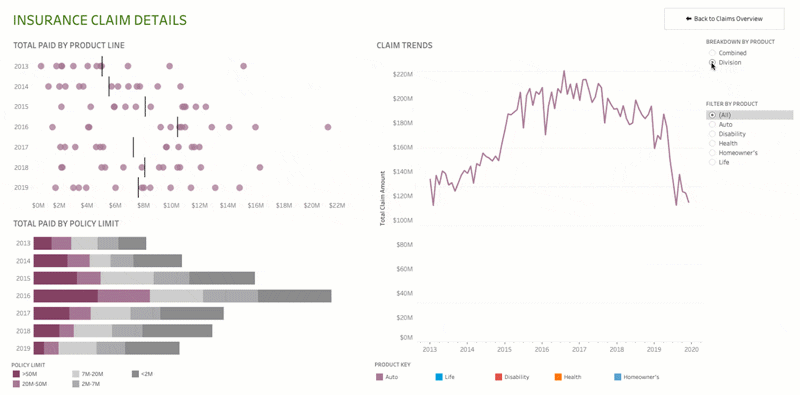
Tableau's Visual Analytics tools take aided various firms in better understanding their consumer information. Let's explore some of the remarkable features offered by Tableau:
- Multipurpose Dashboard: Users can deploy interactive models and various formats with Tableau. Analysts working on dissimilar projects at the aforementioned time can hands move all the elements used in one worksheet to another with an informative, powerful yet simple-to-use Dashboard.
- Information Extraction: Tableau has various data source capabilities for connecting to and importing data from a wide range of external sources. Most data sources, such equally Large Data, Relational Databases, Cloud Data, & Excel Spreadsheets, can be quickly deployed. In this post ahead you volition learn more virtually the Tableau Excel integration.
- Collaborative Sharing: Users can interact with their colleagues on Tableau for collaborative work or review. Users tin can likewise share the dashboard to the cloud, making it available from anywhere.
- Extensive Data Sources: Tableau provides 200+ connectors that let users to securely connect to other data sources such as RDBMS, Deject, spreadsheets, and more. Information technology besides has several monitoring tools, including data connection, auto-refresh, and so on.
What is Excel?
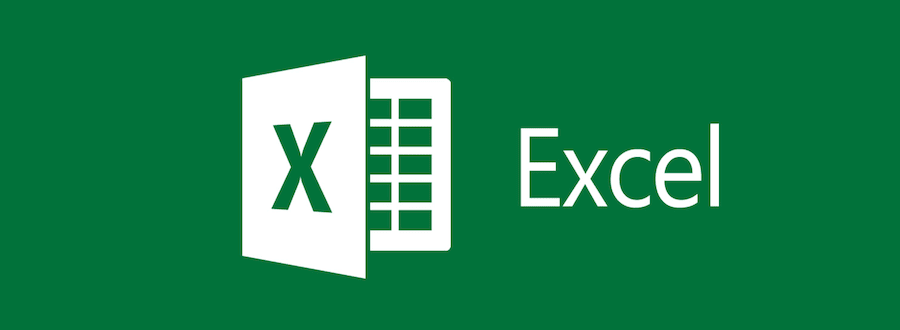
Microsoft Excel is a Microsoft Spreadsheet Application that is function of the Microsoft Function Suite of Applications. It is compatible with Windows, macOS, & Android. It facilitates the generation of text and numeric grids, supports calculation formulae, graphing tools, pivot tables, and the VBA(Visual Basic for Applications) macro programming language.
Microsoft Excel is used to record data in the form of tables. The data might be anything from a regular planner to an organization's spending data. It also assists in the analysis and display of data recorded in spreadsheets.
Primal Features of Excel
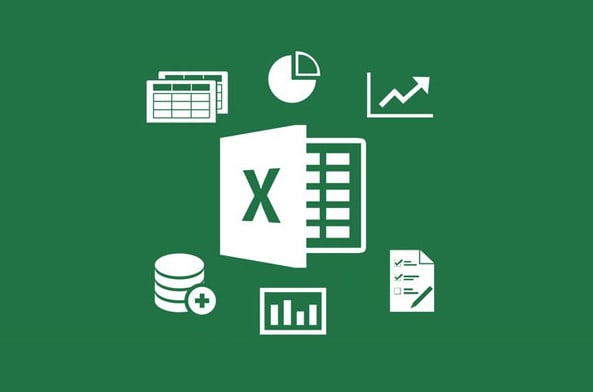
Some of the key features of Microsoft Excel are:
- Built-in Formulae: Excel supports basic to complex built-in formulae for sum, boilerplate, minimum, and others.
- Conditional Formatting: You can apply formatting to a prison cell or a range of cells in MS Excel, and the formatting will change depending on the cell's value or the value of a formula.
- Data Sorting & Filtering: In Excel, you can quickly execute simple data sorting and filtering operations on your data. Information technology likewise supports advanced filtering options.
- Index-Lucifer: Index-Match is one of the almost powerful Excel function combinations. It tin seek a value in a Large Data Table and return its equivalent.
- Protection & Security: Microsoft Excel safeguards your work in a variety of ways, such as preventing unauthorized access to a Workbook, allowing Read-Merely access, or simply protecting a Worksheet so that no equations are accidentally removed. MS Excel likewise has a reliable data recovery solution.
Why practise y'all need Tableau Excel Integration?

Excel is one of the widely used spreadsheet software. For many corporate users, information technology's the go-to belittling and spreadsheet software. It'due south even more powerful with Tableau. Your data is at the heart of Tableau. The underlying data determines how practiced you are at studying data, answering questions, and creating visualizations for yourself or others to consume. Some of the advantages of using Tableau Excel together are:
- Tableau makes Excel data exploration quicker and easier with its drag-and-drop approach to visual analysis.
- Instead of running divide reports or cantankerous-tabs for each inquiry, you tin ask and answer questions as you lot go in the Tableau.
- Tableau visuals are dynamic and easily shared, assuasive everyone in your company to access information.
Hevo Data, a No-code Data Pipeline, helps load data from whatever data source such as Databases, SaaS applications, Cloud Storage, SDK,due south, and Streaming Services and simplifies the ETL process. Information technology supports 100+ Data Sources including 40+ Complimentary Sources. It is a iii-step procedure by just selecting the information source, providing valid credentials, and choosing the destination.
Hevo loads the information onto the desired Information Warehouse/destination in existent-time and enriches the data and transforms it into an analysis-fix grade without having to write a unmarried line of code. Its completely automatic pipeline, fault-tolerant, and scalable architecture ensure that the data is handled in a secure, consistent fashion with zippo information loss and supports different forms of data. The solutions provided are consistent and work with different BI tools such every bit Tableau.
Become STARTED WITH HEVO FOR Gratis
Check out why Hevo is the Best:
- Secure: Hevo has a fault-tolerant compages that ensures that the information is handled securely and consistently with zippo data loss.
- Schema Direction: Hevo takes away the dull job of schema direction & automatically detects the schema of incoming information and maps information technology to the destination schema.
- Minimal Learning: Hevo, with its simple and interactive UI, is extremely simple for new customers to work on and perform operations.
- Hevo Is Built To Scale: Equally the number of sources and the volume of your data grows, Hevo scales horizontally, treatment millions of records per minute with very footling latency.
- Incremental Data Load: Hevo allows the transfer of data that has been modified in existent-time. This ensures efficient utilization of bandwidth on both ends.
- Alive Support: The Hevo team is bachelor round the clock to extend exceptional support to its customers through chat, email, and support calls.
- Live Monitoring: Hevo allows yous to monitor the data flow and bank check where your data is at a detail signal in fourth dimension.
Simplify your Data Assay with Hevo today!
SIGN Upwards Here FOR A fourteen-Day FREE TRIAL!
Steps to Prepare Upward Tableau Excel Integration
Now that you have explored the importance of loading your Excel Data into Tableau, in this department you will work easily-on with it. Follow the steps beneath to work with Tableau Excel Integration:
Step 1: Open your Tableau. On the left side, under the Connect tab, click on the Excel or Microsoft Excel option as shown below.
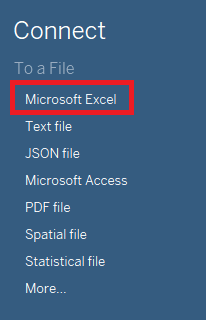
Stride 2: Now a dialog box volition be displayed. Choose the required Microsoft Excel workbook on your auto from where you want to import the data to Tableau as shown beneath.
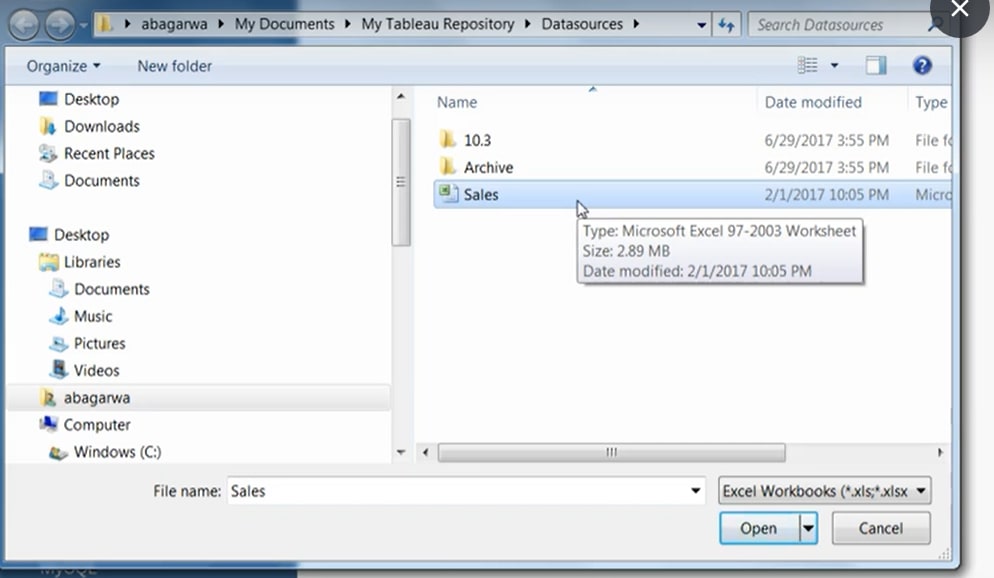
Stride three: Next, click on Open up as shown in the above screenshot. All your sheets will be automatically imported to Tableau. Yous can see the imported sheets on the left side of the Tableau window. You lot can now elevate and drop your tables and perform Tableau operations to get insights into your data equally shown beneath.
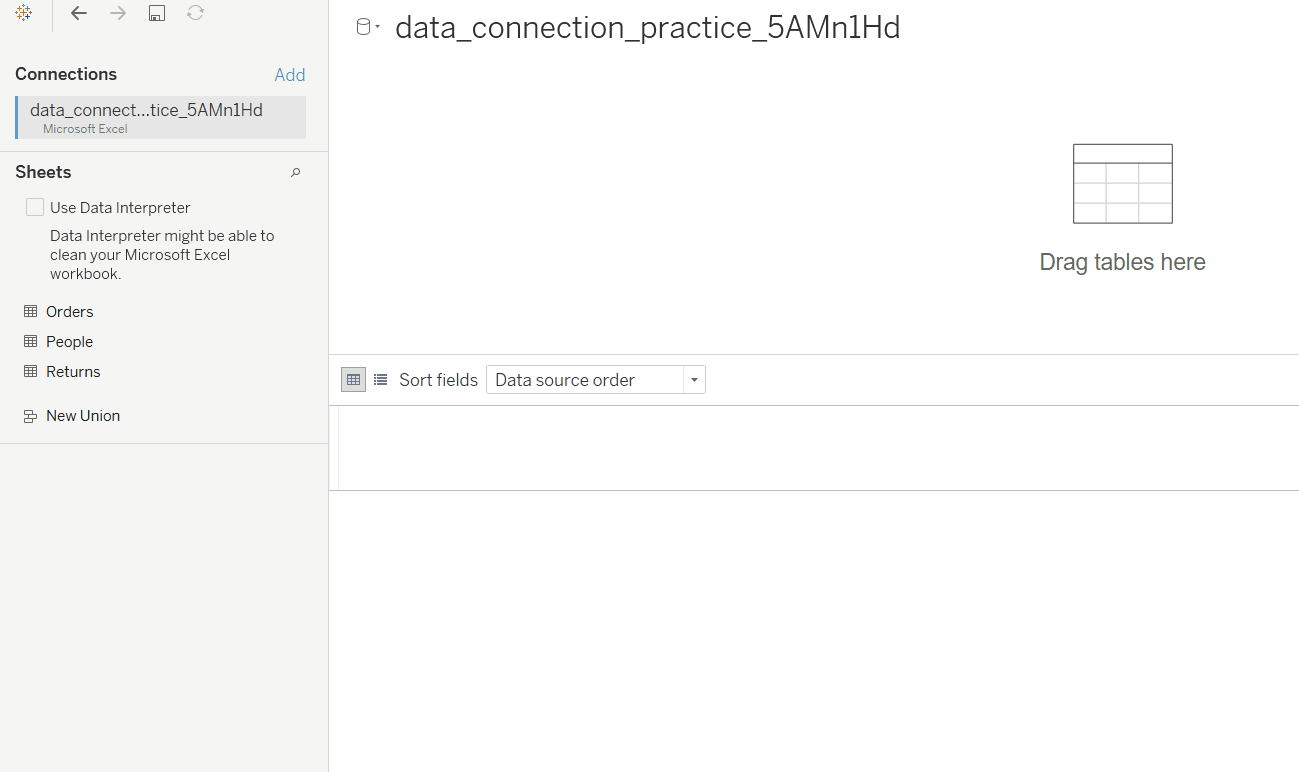
Tableau Tips for Working with Your Excel Data
Data can be arranged in many means. Tableau advises users to connect to Excel data that has been structured for assay to get the most out of Tableau Desktop. Some of the points to go on in listen while loading your Excel data to your Tableau are:
- Tableau Excel Tip: Remove Pre-Aggregated Data
- Tableau Excel Tip: Pin Information in Crosstab Format
- Tableau Excel Tip: Remove/Exclude Introductory Text
- Tableau Excel Tip: Flatten Hierarchical Headers
- Tableau Excel Tip: Remove Blank Rows
1) Tableau Excel Tip: Remove Pre-Aggregated Information
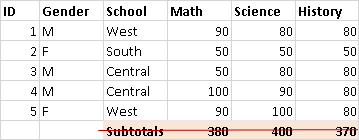
Information is frequently pre-aggregated. That is, data can include sums, averages, and medians, among other things. Subtotals and m totals are 2 examples of pre-aggregated information that are usually used. The data for subtotals and grand totals are computed from the raw information, merely it is non part of the original data. Pre-aggregated data must be eliminated in this scenario.
Remove pre-aggregated information from your table manually and then using the totals option, you can link to your Excel data from Desktop and produce subtotals and totals. Or you tin connect to your Excel data from Desktop, actuate Information Interpreter, and then select the totals option.
ii) Tableau Excel Tip: Pivot Data in Crosstab Format

Tableau Desktop is designed to work with data that is organized in rows. Variables are kept as row values in a row-oriented table. The tabular array is cavalcade orientated when the data is presented in crosstab format. Variables are kept as column headers in a column-oriented table. By manually altering your Excel data, you lot can pin the columns in the rows. Or y'all tin connect to your Excel data from a desktop computer and then use the pivot choice.
3) Tableau Excel Tip: Remove/Exclude Introductory Text
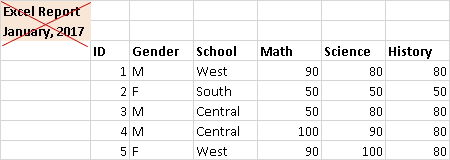
Titles or blocks of introductory text can exist included in Excel data that is presented as a written report. This data might cause complications during your analysis since Tableau Desktop requires either column headers or row values in the first row of a table. To remove the introductory text, you can follow 1 of the following methods:
- Remove this information from your Excel spreadsheet manually. Then, from the Desktop, connect to your Excel data and employ the title option to add a study title.
- Connect to your Excel data using Desktop, then switch on Data Interpreter and select the title option.
four) Tableau Excel Tip: Flatten Hierarchical Headers

Tableau Desktop requires column headings in the first row of your Excel data. Multiple layers of column headers in your data might pose issues during assay. The hierarchy of headers must exist flattened or deleted in this scenario. You tin can attain this past manually creating a new column in your Excel data for each bureaucracy heading or using Tableau Desktop to connect to your Excel data and then switching on Data Interpreter.
v) Tableau Excel Tip: Remove Blank Rows
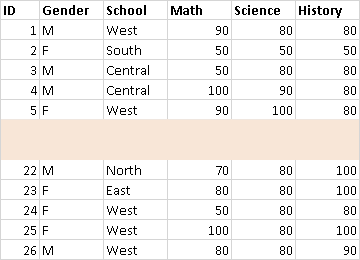
Y'all should make sure that your data doesn't have any blank rows. To delete blank rows, you must first remove them from your Excel data.
To explore other significant points by Tableau, you can refer to Tips for Working with Your Information.
Conclusion
In a nutshell, this mail service helped you proceeds a ameliorate understanding of Tableau and Excel. You understood the need for connecting Tableau Excel and why to import information from Excel to Tableau. Furthermore, you learned how to work with the Tableau Excel integration. In addition, you discovered some of the formatting points to proceed in mind while loading your Excel data to Tableau.
Still, as a Programmer, extracting complex data from a diverse set of data sources like Databases, CRMs, Project management Tools, Streaming Services, Marketing Platforms to your desired destination can seem to be quite challenging. Moreover, analyzing and visualizing your data by loading it from a Data Warehouse to your Tableau can exist cumbersome. This is where a simpler alternative like Hevo can save your solar day!
Hevo Information is a No-Code Data Pipeline that offers a faster fashion to motion data from 100+ Information Sources including 40+ Free Sources, into your Data Warehouse to exist visualized in a BI tool such as Tableau. Hevo is fully automated and hence does not require you to lawmaking.
VISIT OUR WEBSITE TO EXPLORE HEVO
Desire to take Hevo for a spin?
SIGN UP and experience the characteristic-rich Hevo suite offset hand. You tin also have a look at the unbeatable pricing that will help yous choose the correct plan for your business needs.
Do you lot have any doubts? Experience free to ask or share your feel of working with Tableau Excel in the comments section below!
rodriguezconiefor.blogspot.com
Source: https://hevodata.com/learn/tableau-excel/
0 Response to "How to Upload Excel File to Tableau"
Post a Comment